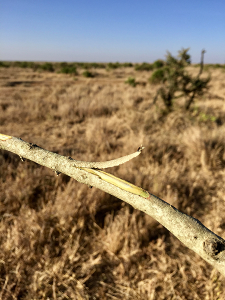Unlike the deliciously exaggerated sugar-and starch-filled produce of today, wild foods are often tough, bitter, astringent, or intensely vegetal, including many prized plants in older cultures. Modern palates aren’t adapted to these flavors. Which brings us to inner bark.
Phloem, the inner bark of trees, is the living layer below the outer bark where photosynthates are transported. Inner bark can be peeled or scraped off for food. Sometimes pulling into even thinner layers reveals a sweeter center. Along with sucrose, you’ll get vitamin C, iron, calcium, and plenty of fiber.
Until last year, snacking on wood seemed laughable to me, and not worth the injury to the tree. Then Hazen Audel, a survival instructor, dropped by my jobsite where we were removing a black locust. He handed me a thick spongy piece of inner bark torn from a branch and said, “Try this, but not too much, because it’s toxic and used in Syrup of Ipecac.” I chomped down with guarded enthusiasm, yet was amazed with the soft sweetness. Inner bark tastes good. To regard it as only useful for survival is an unjustified categorization.
With the epiphany of tastiness came another — one doesn’t have to harm trees to indulge in inner bark. At the end of winter there are always damaged branches or trees that can be thinned to improve forest health. This is how you will find ecologically ethical harvests.

Inner bark can be collected year-round but is best in spring when the sap flows. This is also when it readily separates from the tree. The Coeur d’Alene Tribe called May the ‘‘bark loose on tree month.’’ Historically, inner bark was eaten more often by people in northern latitudes, cinnamon being one notable exception. North Idaho and Western Montana natives along with people from Nordic countries ate it fresh, roasted, fried, and ground into flour for crackers and bread or mixed with fat, blood, or milk. The Finnish even carried it as gifts for distant relatives when traveling. Ancient “window panes,” sections of bark harvested centuries ago, can still be found in certain forests including our own. Bears, rabbits, rodents, and porcupines enjoy inner bark as well. I recently visited the rugged bush of Kenya, where elephants tear apart trees during droughts to get at the phloem, and the Samburu tribe members chew on a relative of ebony when moving cattle.
In the Inland Northwest, native trees to sample are birch, fir, tamarack, spruce, aspen, mountain ash, maple, hemlock, and pine. Our three endemic pines are supposed to be the tastiest of the genus, though white pine requires cooking to be digestible. Aspen and maple are sweeter yet thinner.
Eating inner bark fulfills the primary incentives that drive me to wild foods: connecting with the natural world and knowing the nature of something through its texture and taste. I find a deep sense of satisfaction and enrichment from these raw flavors of feral plant life.
Identifying Attributes: Phloem is distinguished by its softness and light color. If edible, the bark and wood are also edible albeit hard, so worse case you’d dull your teeth if gnawing on the wrong section.
Cautionary Points: Beware of trees with poisonous bark such as yew, horsechestnut, and buckthorne.
Culinary Attributes: From sweet and starchy to chewy and tannic or resinous. Best cooked if you are eating a larger amount due to the abundance of resins, terpenes, and tannins. Can be fried into chips, dried and made into flour, boiled, or eaten raw. //
Kelly Chadwick is an arborist and owner of Spirit Pruners. He wrote about bunchberries in August.













